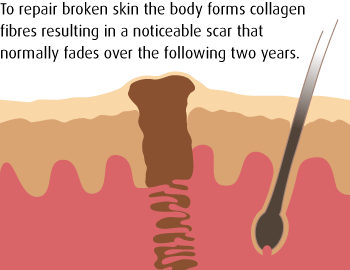Scar formation is a natural part of the healing process and occurs when the skin repairs wounds caused by accident, surgery or disease. The more the skin is damaged, the longer it takes to heal and the greater the chance of a noticeable scar.
The way a scar forms is affected by age, location and certain genetic factors. Younger skin is more susceptible to over-development when healing, resulting in larger, thicker scars. Initially a scar can appear red and thick and then may gradually fade over time.
The rebuilt collagen fibres (see illustration) do not only change the skin visually: parts of skin with scar-tissue are limited in functionality (no hairs and sweat glands) and movement.

Skin healing is slower in older people while younger skin tends to “overheal”, forming larger, thicker scars[1]
People of African and Asian descent, with highly pigmented skin, are especially prone to abnormal scars, such as Keloids [1-3]
Scars over or near muscles that are particularly active, such as the back, legs, shoulders and joints, often spread or become more visible than scars formed on less active areas[1]


